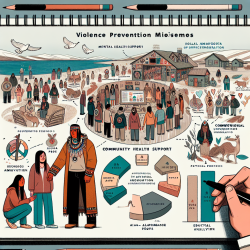Introduction
Homicide remains a significant public health concern for American Indians and Alaska Natives (AI/ANs), with intimate partner violence (IPV) playing a substantial role, particularly among females. The study titled "Homicides of American Indians/Alaska Natives — National Violent Death Reporting System, United States, 2003–2018" provides critical insights into the circumstances surrounding these tragic events. This blog aims to help practitioners understand these findings and encourage further research to improve prevention strategies.
Key Findings
The research analyzed data from the National Violent Death Reporting System (NVDRS) across 34 states and the District of Columbia, revealing several critical insights:
- The AI/AN homicide rate was 8.0 per 100,000 population, with a higher rate in males (12.0) compared to females (3.9).
- Firearms were used in nearly half of the homicides (48.4%), with a higher prevalence among males.
- Intimate partner violence was a significant factor in 45% of female homicides.
- Most suspects were male (80.1%), and a significant proportion were known to the victim.
Implications for Practitioners
Practitioners working in AI/AN communities can leverage these findings to enhance their violence prevention efforts. Here are some actionable steps:
- Community Engagement: Collaborate with tribal leaders and community members to develop culturally relevant prevention strategies.
- Education and Awareness: Implement educational programs that address IPV and its consequences, tailored to the cultural context of AI/AN communities.
- Data-Driven Interventions: Use NVDRS data to identify high-risk groups and circumstances, allowing for targeted interventions.
- Support Services: Enhance support services for IPV victims, including counseling and legal assistance, ensuring they are accessible and culturally sensitive.
Encouraging Further Research
While the study provides a comprehensive overview, there is a need for ongoing research to explore the nuances of AI/AN homicides further. Practitioners and researchers should focus on:
- Examining the impact of socioeconomic factors and historical trauma on violence in AI/AN communities.
- Developing and evaluating community-specific prevention programs that incorporate traditional knowledge and practices.
- Investigating the effectiveness of current interventions and identifying areas for improvement.
Conclusion
Understanding the unique challenges faced by AI/AN communities is crucial for developing effective prevention strategies. By leveraging data from studies like the NVDRS and engaging with community stakeholders, practitioners can create meaningful change and reduce the incidence of homicides. For those interested in delving deeper into the research, the original study provides a wealth of information and can be accessed here.










